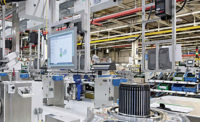Transmissions are one of the most critical subassemblies in automobiles. Unless clutches, gears, recoil inserts, transfer cases and hundreds of other components are installed correctly, even the sportiest vehicle in the world won't get too far down the road.
The Saarbrucken, Germany, plant of ZF Getriebe GmbH serves as the flagship of the driveline technology division of ZF Friedrichshafen AG (Friedrichshafen, Germany). The facility assembles four-speed, five-speed and six-speed automatic transmissions that are used in some of the quickest passenger cars on the road, such as the Audi Q7, the BMW 3-series, the Jaguar XK8 and the Porsche Cayenne. Since it opened in 1973, the plant has produced more than 10 million transmissions.
Every day, operators assemble 4,000 powertrains in 14 basic types and 120 different models. That high-mix environment requires a strictly organized, automated production process that integrates even the simplest procedures.
The facility recently began using a new class of compact color area sensors to inspect sealing plugs. The dust-proof and splash-proof sensors can learn up to 16 different color samples without programming and save them internally.
The sensors can also complete up to 30 inspections per second. One key step checks the sealing plugs before and after the transmissions are washed to remove oil, dust and other residue. The plugs cover the connections for the cooling system and prevent water from entering the interior of the transmission housing. Since the washing process creates internal pressure, the vision system ensures that the plugs have not been pushed out of their coupling holes.
The correct fit of the yellow-, white- and orange-colored plugs is automatically checked with intelligent cameras from Siemens AG (Munich). Before the washing cycle begins, the Simatic VS 710 cameras acquire complex grayscale images and compare them with nominal samples. After the washing cycle is completed, only the presence of the plugs needs to be checked.
Many different industrial cameras were investigated by ZF engineers. While searching for a rugged, cost-effective solution, they thoroughly tested a Simatic MV220 color area sensor in a pilot project. They were looking for a way to adjust the sensor quickly and easily to different inspection tasks without complex programming or profound image processing knowledge. This was a mandatory requirement, since different colored sealing plugs are placed at various points on the different types of transmissions.
The engineers selected the color area sensor because of its dust-proof and splash-proof enclosure, which meets the IP65 degree of protection and integrates all required components and features. Besides the actual color area sensor, these include an I/O interface for digital data exchange with the controller, a laser-based alignment aid and lighting. The compact device, which measures 113 by 35 by 90 millimeters, takes up very little space on the assembly line.
A control panel is located at the top of the device. With only a few steps, up to 16 OK-images can be taught and stored in the sensor, which are then analyzed and compared to the sample photos. The exposure time, white balance and brightness correction are automatically adjusted by the device. Focusing takes place semiautomatically. Operators only have to pay attention to the detection window, which can be sized via an adjustable screw to match the task.
The process of inspecting the sealing plugs is fully automatic. Various types of transmissions are identified by a radio frequency identification system that is attached to the assembly carts. The information is transmitted by a visualization system to the inspection stand controller. This controller activates the corresponding OK-image via the digital inputs of the color area sensor, briefly stops the assembly line and triggers the sample photo at the right moment.
The sensor can process up to 30 pictures per second. It also can inspect considerably smaller objects in rapid succession. The sensor offers two basic operating modes: A matching mode for inspecting areas for all colors and a recognition mode for identifying specific color characteristics in a defined quantity.
The classification of the inspection result takes place in the sensor and is sent back to the mobile data storage unit via the digital outputs, the controller and the visualization system. The data storage unit contains a complete product history.
To make sure that the inspection system is functioning correctly, ZF engineers run a reference master-a "faulty" transmission without plugs-through the inspection stand three times a day. Any downtime of the overriding control system due to maintenance or other factors is bridged by an offline table in the controller. It locally stores the last 10 transmissions checked.
The inspection system has been running reliably and cost efficiently for more than 6 months. Engineers who configured the color area sensor for the pilot application praise its intuitive teach-in procedure, as well as the variable adjustment of the image window and object distance. It shortens changeover times without having to forego powerful image processing features.
